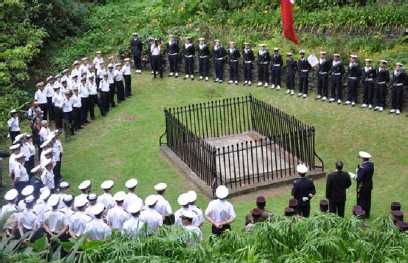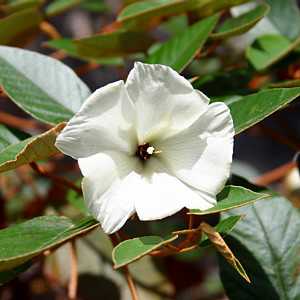⏱ QUICK READ
At his own wish, Napoleon was buried in Sane Valley, a peaceful spot for quiet contemplation which he often visited when he was alive. But Napoleon’s body is no longer there… On this page we introduce the beauty of the spot, record the details of his burial, and then explain what happened nearly twenty years later.
Napoleon died in exile on St Helena on 5th May 1821.
The burial

Napoleon’s coffin was not by any means of normal construction - it had four layers. As can be seen from the diagram (right), the outer layer was mahogany{6}; inside that was a lead coffin; inside that was another mahogany coffin, and inside that was a tin coffin lined with white satin and stuffed with cotton (with a pillow to match). It could fairly be said that Napoleon would have been more comfortable sleeping in death and he had frequently been (for example, on campaign) sleeping while alive.
Events on 5th MayEvents for your choice of dates on our page Chronology. | Tomb DecisionsIn his will Napoleon asked to be buried in Paris on the banks of the Seine, but the British Governor Hudson Lowe insisted he should be buried on St Helena, in the Valley of the Willows (a.k.a. Sane Valley). The funeral took place on 9th May 1821. Lowe said the inscription should read ‘Napoleon Bonaparte’; Napoleon’s friends, Montholon and Bertrand, wanted the Imperial title ‘Napoleon’ - by convention royalty were signed by their first names only. Unable to resolve the dispute the tomb was left nameless, as it remains today. The Tomb was one of the 2008 Seven Wonders of St Helena (but not one of the 2018 set). |
In around 1830 a visitor to St Helena was charged 3s (£0.15) to see the tomb.
Removal and re-burial
Napoleon’s body is no longer in the tomb. On 5th May 1840, on the 19th anniversary of his death, the French Government requested the return of his body. It was collected in October 1840 by the Prince de Joinville. Work began at midnight on the night of the 14/15th October, the anniversary of the Emperor’s arrival, and by 9:30am the coffins were exposed to view. Napoleon had been buried in four coffins in the following order: tin, mahogany, lead and mahogany. On his death the mahogany required for the coffins could not be obtained on the Island so Captain Bennett, an officer of the St Helena Regiment, who then lived at Chubb’s Spring, presented his dining table for the purpose. The Prince de Joinville had brought with him a lead coffin, an ebony casket to enclose it and a beautiful pall emblazoned with the Imperial bees. At the exhumation the outer mahogany coffin was broken up, but the remaining three were placed in the lead one brought from France and then deposited in the ebony casket. Not until then were they opened for the purposes of identification. The state of preservation of Napoleon’s body was described at the time as excellent, which led later to suspicions that his death was caused by arsenic poisoning, a known preservative. The body and its coffins were loaded onto the frigate La Belle-Poule, which had been painted black for the occasion, taken back to France and re-buried in L’Hotêl Les Invalides.
Apparently the loading of Napoleon’s body onto La Belle-Poule was marked with a 17-gun salute fired from the western end of the Jamestown Lines. It is claimed by G. C. Kitching that this resulted in the cost of repairing broken windows in many neighbouring houses being added to the bill for the whole affair! This was, it seems, the last time these guns were fired…
Although Napoleon’s body no longer resides there, the land in which the tomb stands was sold in 1858 to the French Government along with Longwood House for a sum of £7,100.
Remembrance

Despite the tomb being empty, it is a popular spot with visitors, who like to experience the peace of this quiet place and spend a little time contemplating the life of Napoleon.
A ‘Moment de Memoire’ is held at the site every year on the anniversary on Napoleon’s death. Here is the report from the 8th May 2014 issue of The Sentinel:
A solemn and moving ceremony to commemorate the death of Napoleon in 1821, took place around the Tomb on Monday 5th May with the French Republic flag flying overhead.
Fr. Dale Bowers led the short ceremony. It included prayers, the Scouts sounded the Last Post and Reveille, two minutes silence, wreaths were laid in Napoleon’s memory, and student Thomas Hickling gave a well rehearsed address in French, on behalf of Prince Andrew School students.
The commemoration ended with a blessing by Fr. Dale, after which Monsier Martineau thanked everyone for attending, and invited those gathered on the footpath down to the Tomb to pay their respects.
It was overcast, wet under foot with frogs croaking, but the turnout didn’t disappoint. Approximately 75 people attended, including the Honorary French Consul, Monsier Michel Martineau, His Excellency the Acting Governor, Mr Sean Burns, Mrs Susan O’Bey on behalf of la Fondation Napoleon, Prince Andrew School students learning French along with their teachers, councillors, and members of the public.
This was the fourth Moment de Memoire commemoration in St Helena. It took place alongside the ceremony in Les Invalides in Paris, France, where Napoleon’s body is now interred.
Bicentenary, 2015-2021
To learn more about the events held to mark the Bicentenary of Napoleon’s time on St Helena, please see our page Napoleonic Bicentenary.
Do not try to make a living island exist on a dead man’s memory.{h}
Many mostly-older Saints still make use of ‘traditional remedies’, including Balm of Gilead which grows in the Tomb area.
Read More
Below: Websites: Napoleon on Saint Helena Article: The Entente Cordiale Alive and Well Lego Seven Wonders Voting
French Consulate Factbox
Websites: Napoleon on Saint Helena
(two sites)

There is lots more about Napoleon and his time on St Helena on these two sites, both of which happen to have the same name:
Please Note there are many, many sites about Napoleon. These are just two we have chosen to mention. If you think there is one we should include please contact us.
Article: The Entente Cordiale Alive and Well
By Vince Thompson, published in The Independent 17th April 2014 (on the occasion of the visit of French Navy ships FS Mistral and FS La Fayette to St Helena)

The visit to St Helena by 400 French soldiers and seamen meant a ceremony at Napoleon’s Tomb had to become part of the plans. During his speech at the ceremony the Captain of The Mistral, Francois-Xavier Polderman, thanked Michel Dancoisne-Martineau for the tireless effort he expended to make the visit and tomb ceremony a success.
The edge of the flat area around the tomb was lined by representatives of the various regiments, detachments and brigades who made use the companies of the two ships. In one corner was a choir made up of sailors. In the observation area above the tomb many more sailors and seaman together with some St Helenians watched the ceremony. The home port for The Mistral is Toulon, on the southern, Mediterranean coast of France. Just south of Toulon is the island of Corsica where Napoleon was born.
The ceremony started with some recorded music; this was followed by speeches, first from Captain Francois-Xavier Polderman and then from Governor Capes. Captain Polderman referred Napoleon’s exile and the various wars between England, and later Britain, and France throughout 1,000 years of history. He concluded by saying that for the last 199 years Britain and France had fought on the same side and that now, the destinies of both countries were closely linked. The governor responded by saying he shared the Captain’s views on a shared destiny and told the assembled company they will always be welcome in St Helena. The choir sang three times, including the national anthems of Great Britain and France.
In Lego
We found this on the Internet:
Seven Wonders Voting
The appeal (right), made by Trevor Magellan, was broadcast on Radio St Helena prior to the 2008 Seven Wonders voting:
Credits:
{a} Domaines Français de Sainte Hélène{b} John Isaac Lilley, 1861-1866{c} By Charles Marie Boulton (Paris, 1781-1853){d} TOP LEFT: Attributed to John Kerr, Paymaster of the 66th Regiment, ‘Series of views in the Island of Saint Helena’, dedicated by permission to Lady Lowe, London, Colnaghi & Co. 1822; TOP RIGHT: ‘Burial of Napoleon Bonaparte at St Helena’, attributed to James Pattison Cockburn (1779-1847); BOTTOM: From the book The Drama of Saint Helena by Paul Frémeaux, 1910{e} Jean-Baptiste-Henri Durand-Brager{f} Sebastian Mayer{g} Spike Milligan: Epitaph on his tombstone{7}{h} Diocesan Magazine, Letter to the Editor, January 1933{i} Manfred Rippich/Radio St Helena
Footnotes:
{1} A rare image of the Tomb before Napoleon’s body was removed.{2} It looks like guarding an empty tomb was a far from stimulating job!{3} We’re not sure about the rising star. We’ve never seen this phenomenon, but then we’ve never been to the Tomb at night. Or maybe it’s just artistic license…{4} On display on the third floor of the Museo Napoleónico, La Habana, Cuba.{5} We don’t know who made this model. If it was you, please contact us so we can attribute this fine creation!{6} There is an amusing myth about where the wood for the coffin was sourced.{7} Actually inscribed in Gaelic as Dúirt mé leat go raibh mé breoite because the Church would not allow it to be written in English.



